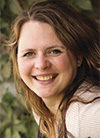To read this article in French, click here.
With the shorter days and darker mornings, I’ve had a harder time getting out of bed to go tackle the day and all it promises to bring. Despite making tweaks to my calf feeding schedule to do as little in the dark as possible, it feels like all I do this time of year is work in the dark. Can I get an amen?I’ve been hearing from farmers – even seasoned ones – far and wide that this has been the most stressful harvest season in recent memory. When you pair exacerbated difficulties with the day-to-day routine (and all its challenges) of running a farm and literally not enough daylight to get everything done in a day that we need to get done, we have a perfect storm for seasonal affective disorder (SAD), a form of depression that often strikes in the fall and lasts into springtime, according to the National Institute of Mental Health (NIMH).
Depression, particularly SAD, is often found in individuals who have difficulty regulating serotonin, a key neurotransmitter in regulating mood activity. Individuals with SAD also have been found to overproduce melatonin, the hormone that regulates sleep and circadian rhythm. This phenomenon is caused by shorter day length in late fall and early winter. In addition, those with SAD may produce less or be deficient in vitamin D, which is closely linked with serotonin production.
According to NIMH, seasonal affective disorder is not considered as a separate disease as much as its own subset of major depression. Symptoms of major depression include:
- Feeling depressed most of the day, nearly every day
- Feeling hopeless or worthless
- Not having enough energy to do what you need to do
- Losing interest in hobbies and activities
- Sleep problems (either sleeping too much or insomnia)
- Weight and/or appetite changes
- Feeling sluggish
- Easily irritated or emotional
- Crying spells
- Difficulty concentrating and focusing
- Suicidal thoughts
Seasonal affective disorder-specific symptoms, in addition to classic major depression criteria, may also include, but are definitely not limited to:
- Craving for carbohydrates (‘comfort foods’)
- Sleeping too much
- Social withdrawal or ‘hibernation’
NIMH states that risk factors for SAD include but are not limited to:
- Being female (females are four times as likely as males to be diagnosed with SAD)
- Living far from the equator
- Family history
- Already having a prior diagnosis of depression or bipolar disorder
- Younger age
If you or someone you know is currently experiencing any of these symptoms, please reach out to your primary care physician or a mental health professional to develop a treatment plan. SAD treatment plans often include medication with a selective serotonin reuptake inhibitor (SSRI), light therapy, cognitive behavioral therapy and vitamin D supplementation.
In addition to seeking medical help for depression, do not be afraid to reach out to a trusted family member, friend, neighbor, farm service provider or clergy member to talk to until the sun shines in your world once again.
Lastly, if you have been experiencing suicidal thoughts or know someone that is, contact the National Suicide Prevention Hotline immediately by calling 1-800-273-8255 (TALK) or the Crisis Text Line by texting CONNECT to 741741.






